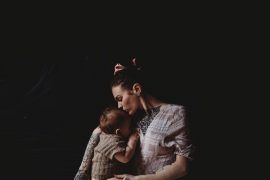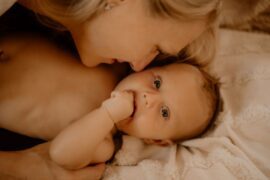Claim #3: Comparing sleep training to leaving a baby for a moment as you attend to another child to cry.
This is the argument we always hear and one that drives me nuts. If your version of sleep training involves leaving your baby for a moment while you pee then going and comforting and providing ongoing support then it’s not sleep training. Leaving a child who is in distress for set or prolonged periods intentionally is what we are talking about. Of course, sometimes children are left as we address other kids, but this shouldn’t happen often and in fact from a historical perspective, babies rarely were left even for these shorter bouts as there were various people around to assist and attend to baby.
Claim #4: Cries are protests to change, not distress.
The author seems to suggest that all crying at night is “protesting” because something is different and unexpected. In some ways, she may be right as children will cry at the unexpected. Humans are creatures of habit and we do get stressed when we experience change. However, again we have to go back to social buffering: We adapt to that change through support not being left. In fact, when we look at the development of emotion regulation, it is dependent upon us adults modelling assistance for our children until they are capable of it themselves and this takes a very long time. The first stage of “self-soothing” in the emotion regulation world is actually a child calling out for you to seek support and comfort. They have realised that they need your support to regulate and so they call for that. If you leave them, they simply don’t have the tools to regulate from a physiological perspective. This is a far bigger topic than for her, but suffice it to say that there is nothing that suggests the idea of leaving a child to “learn” to settle does that in the least and in fact seems to be counter to the development of self-soothing.
Claim #5: Your baby absolutely will not be damaged in any way from any sleep training and you can tell because your baby will still cry for you at other times during the day.
Sometimes I don’t know where to begin and this is one of those times. I think I will bring up the following just to show the ridiculousness of this idea: Children who are abused, neglected, and have severe attachment issues will cry and will still cry for their parents and for their support. I have worked with children with trauma in their history and attachment issues and these kids still reach out to their family when they can.
Seeking support from a caregiver is so hardwired that it takes an immense amount of time and damage to move away from that and that certainly doesn’t happen in infancy or toddlerhood.
You simply cannot take the idea that a child still reaches for you as evidence of anything.
Claim #6: “The levels of cortisol a baby releases during times of short term ‘stress’ are lower (by 100-200%) than the cortisol levels babies (and adults) naturally produce throughout the course of each day”.
This is true, but is irrelevant to the argument. In fact, it holds for adults as well. Most of the “stress” we experience is a fraction of what the normal levels released are in the system, but the typical amounts released are there for specific uses. The problem is not the amount that is released, but the deviation from the normal and natural rhythm, because the body’s response to this temporary increase actually has other implications for development and overall well-being. When we have an increase in stress, it is a signal to the body to do all sorts of other things, like increase heart rate, send blood to the centre of the body, and so on. These things tax the body and we need to recuperate to get over it. If the amount of cortisol were the only issue, we wouldn’t see chronic stress problems in adults either, but the fact remains we have serious health problems in our adult population due to chronic stress. (I strongly recommend reading Why Zebras Don’t Get Ulcers by Dr. Robert Sapolsky for more discussion of the issue of stress on the body.)
Now, you may think that because sleep training isn’t chronic, then the amount matters. The problem with that is that it presupposes we know when stressful situations result in trauma that has lasting impacts and the fact is, we don’t.
Understanding why some individuals experience long-term trauma and others don’t is an ongoing area of research and one I hope we can make greater headway on, but we aren’t there.
If you question this, let me briefly tell you about a case study in Dr. Bruce Perry’s book The Boy Who Was Raised As A Dog. This book is a series of case studies of child trauma and one case was a young toddler who was severely traumatised after parents discovered that the nanny who was watching him during the day was leaving him in his bed all day to cry and be alone. When parents came home they were loving and caring and responsive, so he actually lived in a very responsive environment for a large portion of the time, but those eight hours a day he was left alone. The trauma of being abandoned and left all day (though his parents made sure he was fed and cared for at all other times) was enough to result in a damaged child that needed a lot of help to overcome this temporary abandonment in the context of a loving home.










